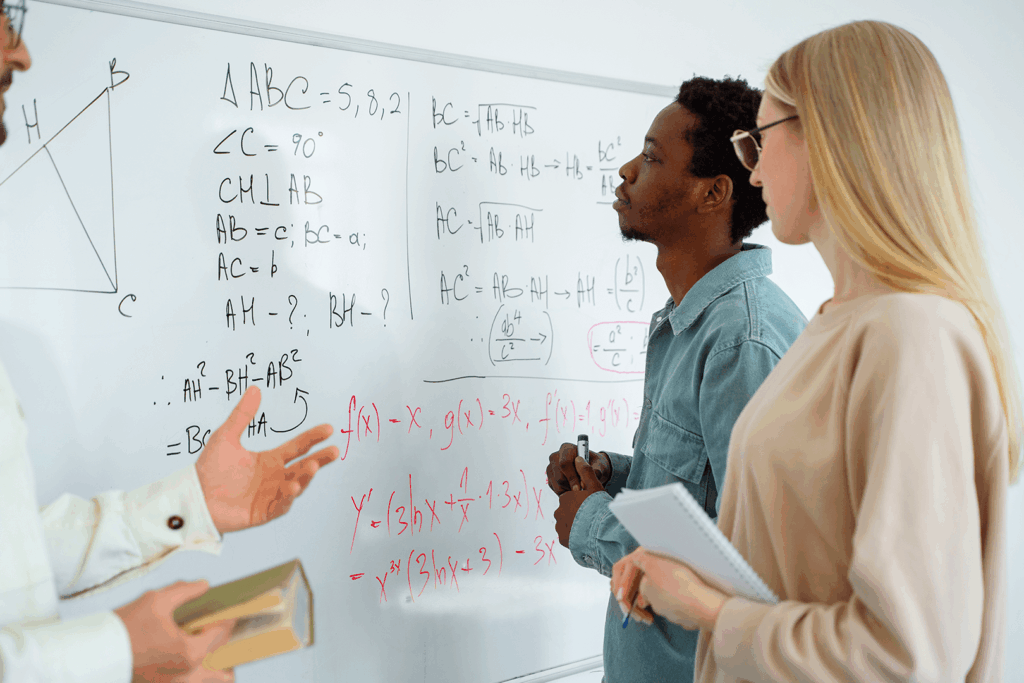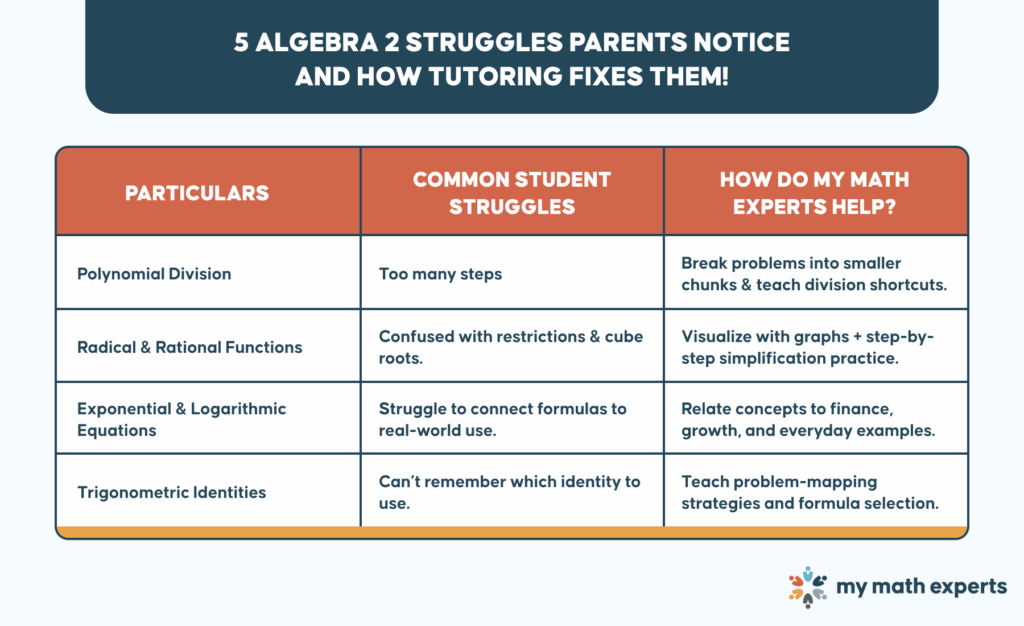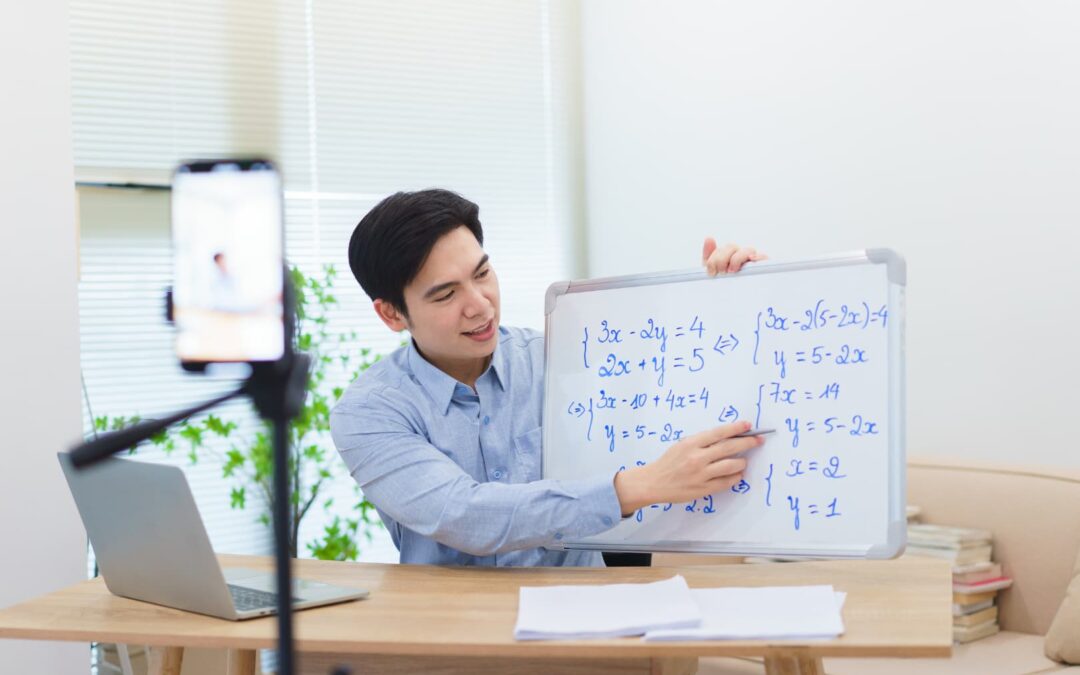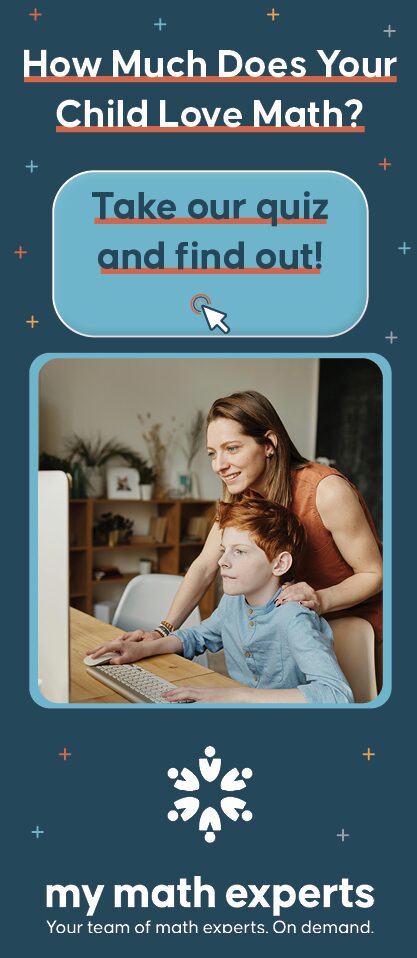Algebra 2 is when students start using algebraic equations in real-life situations. They go beyond just solving equations and begin working with quadratic functions, rational expressions, and exponential equations, concepts that appear in areas such as finance and science. This blog is here to help you understand Algebra 2 by breaking down topics into simple steps and connecting them to what you already know. We’ll share strategies that make solving problems clearer. With good teaching and helpful feedback, your child can master Algebra 2 and new topics more easily.
Key Takeaways
- Algebra 2 builds on Algebra 1, so it’s essential to have a solid foundation in the basics. It adds up quadratic functions, polynomial equations, rational expressions, and trigonometric concepts.
- Core Algebra 2 Concepts and Their Applications
- Advanced Topics in Algebra 2 for Problem Solving
- Working regularly on practice assignments with the right math tutoring support helps in mastering Algebra 2 topics and preparing for college-level math.
- My Math Experts tutors provide students with 1:1 sessions with step-by-step guidance on each topic, assigning and assisting with practice problems, personalized study plans, and math skills.
Core Algebra 2 Concepts and Their Applications

In Algebra 2, students discover how various systems of equations and functions relate. Rather than relying on a single formula, they get to deal with quadratic functions, polynomial equations, and rational expressions that build up to major concepts of solving more complex problems. Constant practice of these areas enables students to comprehend and use linear functions, radical equations, fractional exponents, and the quadratic formula in a variety of situations. This provides a good platform for more sophisticated subjects, including exponential, logarithmic, and trigonometric functions.
Exploring Quadratic and Polynomial Equations
Algebra 2 isn’t just about numbers—it’s about understanding how equations shape patterns. Here’s what students tackle:
- Quadratic Equations & Functions: Learn to solve for x with the quadratic formula and rewrite equations in vertex form, so parabolas make sense on a graph.
- Quadratic Inequalities: Figure out the ranges where solutions work and see them visually.
- Polynomial Equations: Go beyond simple subtraction and master polynomial division to confidently handle multi-step problems.
- Graph Connections: See how equations translate to curves, helping students link abstract concepts to real-world scenarios.
Understanding Rational and Radical Functions
Students also navigate rational functions and expressions, learning to simplify fractions that include variables and solve equations with restrictions. Radical equations and radical expressions, including cube roots, appear frequently, while fractional exponents bridge the gap between radicals and powers, giving students a flexible way to handle complex problems.
Advanced Topics in Algebra 2 for Problem Solving
In Algebra 2, students progress beyond simple equations to understand how math explains the world.
- Exponential & Logarithmic Functions: These are not just formulas. Students model population growth, interest rates, or viral trends. Here, algebra applies to daily life.
- Inverse Functions & Transformations: Flipping or shifting a function changes its graph. This clarity makes hard equations easier to solve.
- Trigonometry in Action: The unit circle and trig ratios aren’t just abstract notions from a textbook; they are tools to address angles, distances, and other geometric problems we encounter daily.
- Developing Analytical Muscle: The ideas contained in the Pythagorean theorem, trigonometric identities, and operations of functions require students to think analytically and assess each problem in a new way, bringing together various ideas and conclusions from different problems.
What’s the big deal? Students cease to memorize mathematics and instead see its logic, which provides students with the confidence to embrace advanced courses (e.g., College Algebra, linear algebra, or any other STEM) with a greater sense of confidence.
Critical Tools and Strategies for Success in Algebra 2
Mastering Algebra 2 marks a shift from the quick-rule memorization typical of Algebra 1 to a deeper interaction with concepts. Rather than relying on isolated formulas, students dive into real numbers, conic sections, and other topics that demand proper analytical tools. Challenging ideas like systems of equations, geometric and arithmetic sequences, and the dreaded word problems are broken into bite-sized pieces, letting students tackle minor questions that gradually build toward complete solutions.
An experienced math tutor speeds up this process, introducing students to scatter plots and sigma notation. Mastering these symbols and graphs nurtures data-analysis habits that apply across the rest of the curriculum and into daily decisions outside the classroom. Students see numbers represented visually, honing the ability to conclude real data.
Shortcuts such as the Factor Theorem, Remainder Theorem, and Binomial Theorem trim the algebraic workload and build confidence. Students learn to shift polynomial tasks from tedious multiplication to quick evaluations. Connections deepen further as absolute value functions and the concept of standard distribution frame the abstract truths of algebra inside tangible contexts like science, finance, and statistics, making every theorem a bridge to everyday decisions.
Study Resources and Support for Algebra 2
Algebra 2 can seem like a wall of numbers and letters for kids who face it alone. Building on Algebra I, this course asks them to divide polynomials, manipulate tricky fractions, and follow rapid exponential growth. Too often, students sink not from a lack of ability but from the little, behind-the-scenes support that would give them the time to practice or the patient, step-by-step explanations that clarify a single breakthrough.
One of the best ways to get help is to practice with a good math tutor. Instead of just going over homework, good tutors figure out exactly why a student is having trouble, like not knowing when to use a certain formula or getting confused about rules for exponents with fractions. At My Math Experts, tutors explain problems one step at a time and provide students with practical tips for tackling various word problems and equation sets. This kind of focused help not only aids with tonight’s homework but also helps students become better problem solvers in the long run.
Teens benefit when parents make a habit of putting practically every Algebra 2 chapter into practice. Loading practice tests or extra algebra explanation books onto the dining-room table creates quiet review time that merges last week’s lecture with a fresh perspective. These pages rehearse the same rules, frame new examples, and warm students up for the tougher problems that future math classes demand. Drawing sketchy plots or recalling those special math rules on practice sheets builds the quiet confidence every correct answer lends while it still feels easy.
Technology can help, too. Graphing calculators make it easier to visualize how lines and shapes change, and online tools can verify answers and illustrate alternative solutions to problems. But without regular study habits, even the best tools will not help much. Practicing often is the only way to really learn the material.
When parents use good resources and get help from My Math Experts, students not only get better grades in Algebra 2 but also learn thinking skills they will use in college math, computer science, and science or technology classes.

What You’ll Achieve with Algebra 2 Help?
When you get a math tutor for your child for Algebra 2 help, he/she will gain more confidence over key algebra concepts like quadratic functions, rational expressions, geometric series, abstract algebra, binomial distribution, Subtracting Polynomials, multiplying polynomials, Function notation, exponential equations, and related questions.
With regular classes with Algebra 2 tutors, they develop strong problem-solving skills applicable to real-world scenarios, college algebra, and future STEM courses.
With personal guidance and an Algebra course plan devised specifically for your child, you will gradually see improvement in their school year grades and a positive end behavior towards high school Algebra.
With regular math tuitions, you will notice that they are more focused on completing their homework and preparing for advanced math topics like trigonometric functions, transformations of functions, trigonometric ratios, systems of equations, polynomial operations, Systems of Linear Equations, and logarithmic applications, which used to be very difficult for them.
By mastering these topics, high school students are ready for college-level math, AP classes, and related challenges in computer science or data analysis.
FAQs
- How can a tutor help my child with Algebra 2?
Every student is different, and that’s why each one of them requires a different approach to study.
A certified math teacher knows exactly how to break down complex topics like quadratic equations, rational expressions, and exponential functions into simple and understandable steps.
- Which Algebra 2 topics are usually the hardest for students?
Students often struggle with polynomial division, radical functions, logarithmic equations, and trigonometric identities. Not generic YouTube classes, but focused and personal math tutoring addresses these areas very well. - How do I know if my child needs extra Algebra 2 help?
Some of the common signs you may notice are:
-
- Difficulty with multi-step problems
- Low test scores
- Frustration when handling systems of equations
- Radical equations
- Exponential growth problems
or any other reason that makes you believe that they are struggling with Algebra 2 or related example problems.
- What resources complement tutoring?
Most courses have a predefined syllabus or a course structure that they follow for every student. That is exactly what we don’t do at My Math Experts. Every student’s plan is customized, and most students’ goals are based on school outcomes, so we often focus on schoolwork, but we have tons of other supplemental tools and resources to help with whatever your goals may be. In addition to focusing on homework, if your goals are focused on your current coursework, we can supplement every one-on-one lesson with curated problem sets, targeted worksheets, and even timed practice tests so learners can solidify new concepts before moving on. Interactive graphing calculators and digital tools let students see transformations, quadratic graphs, and rational strikes come to life, making theory feel tangible. By merging specialized attention with focused practice, we equip each student to face Algebra 2 challenges with assurance, whether in tests or daily homework. - Will this support help beyond high school?
Yes. Mastery of Algebra II concepts prepares students for basic Algebra, college algebra, base formula, single variable, system of equations, trigonometry, calculus, polynomial functions, and STEM-related courses.

